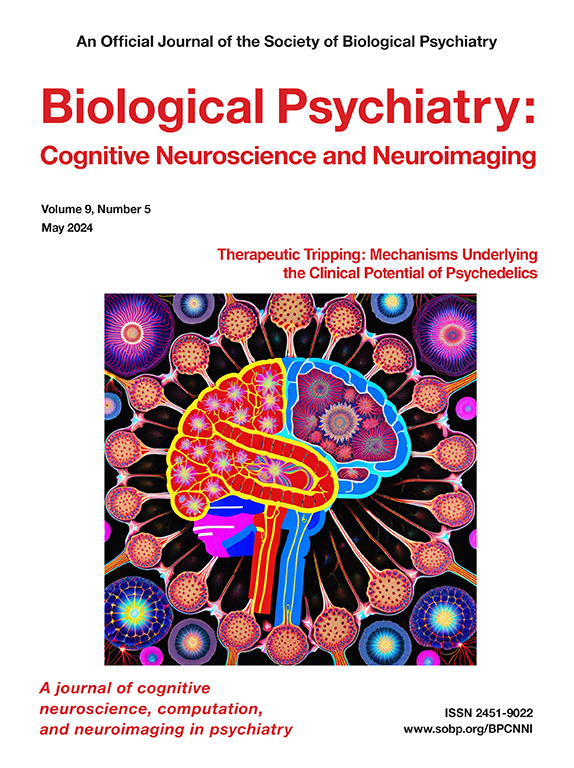注意缺陷多动障碍中神经活动与冲动性基因表达的异常关联:一项青少年大脑认知发展研究。
IF 4.8
2区 医学
Q1 NEUROSCIENCES
Biological Psychiatry-Cognitive Neuroscience and Neuroimaging
Pub Date : 2025-10-01
DOI:10.1016/j.bpsc.2025.06.002
引用次数: 0
摘要
背景:高遗传性注意缺陷多动障碍(ADHD)的冲动性已经通过fMRI或遗传数据使用神经活动进行了研究,但很少使用多变量方法将两者联系起来。我们利用平行独立成分分析(pICA)和青少年大脑认知发展数据研究了耦合的神经活动和基因表达特征。方法:ADHD患儿(n = 394;63%男性)和健康对照(n = 1,000;其中包括欧洲血统的男性(47%)。受试者随机分为80%发现数据组和20%重复数据组,采用人口统计学分层。我们使用pICA分析了发现数据集的神经活动和基因表达,并提取了配对独立分量(pICs)。利用pICs的加载系数来预测复制数据集中停止信号任务(SST)的行为和认知数据。结果:我们从皮层、小脑和伏隔核的基因表达中鉴定出三种pICs。显著的神经活动主要局限于眶/下/中额回、直肠回、楔前叶、颞下回、下顶叶小叶和小脑。重要的基因成分与免疫球蛋白、味觉受体和免疫相关术语相关,并与adhd相关基因重叠。提取的fMRI-/ gene - ic与平均反应时间、停止信号反应时间和行为抑制显著相关,当配对的fMRI-/ gene - ic及其相互作用用于多模态回归分析时,灵敏度大大提高。结论:我们使用异食癖报告了生物学上可信的神经活动和基因组对,它们与ADHD冲动相关的行为和认知数据显着相关。本文章由计算机程序翻译,如有差异,请以英文原文为准。
Abnormal Association Between Neural Activity and Genetic Expressions of Impulsivity in Attention-Deficit/Hyperactivity Disorder: An Adolescent Brain Cognitive Development Study
Background
Impulsivity in highly heritable attention-deficit/hyperactivity disorder (ADHD) has been studied using neural activity via functional magnetic resonance imaging (fMRI) or genetic data, but rarely with multivariate methods that link both. We investigated coupled neural activity and gene expression signatures, using parallel independent component analysis (pICA) and ABCD (Adolescent Brain Cognitive Development) Study data.
Methods
Children with ADHD (n = 394; 63% male) and healthy control children (n = 1000; 47% male) of European ancestry were included. The participants were randomly divided into 80% discovery and 20% replication datasets with demographic stratification. We analyzed neural activity and gene expressions from the discovery datasets using pICA and extracted paired independent components (pICs). The loading coefficients of the pICs were utilized to predict behavioral and cognitive data for a stop signal task (SST) in replication datasets.
Results
We identified 3 pICs estimated from gene expression in the cortex, cerebellum, and nucleus accumbens. Significant neural activity was mainly localized to the orbital/inferior/middle frontal gyri, rectal gyrus, precuneus, inferior temporal gyrus, inferior parietal lobule, and cerebellum. Significant gene components were associated with immunoglobulin-, taste receptor–, and immunity-related terms and overlapped with ADHD-related genes. The extracted fMRI-/gene-ICs were significantly correlated with mean reaction time, stop signal reaction time on the SST, and behavioral inhibition, with a large boost in sensitivity when both the paired fMRI-/gene-ICs and their interaction were used in a multimodal regression analysis.
Conclusions
We reported biologically plausible pairs of neural activity and gene sets using pICA, which were significantly associated with ADHD impulsivity–related behavioral and cognitive data.
求助全文
通过发布文献求助,成功后即可免费获取论文全文。
去求助
来源期刊

Biological Psychiatry-Cognitive Neuroscience and Neuroimaging
Neuroscience-Biological Psychiatry
CiteScore
10.40
自引率
1.70%
发文量
247
审稿时长
30 days
期刊介绍:
Biological Psychiatry: Cognitive Neuroscience and Neuroimaging is an official journal of the Society for Biological Psychiatry, whose purpose is to promote excellence in scientific research and education in fields that investigate the nature, causes, mechanisms, and treatments of disorders of thought, emotion, or behavior. In accord with this mission, this peer-reviewed, rapid-publication, international journal focuses on studies using the tools and constructs of cognitive neuroscience, including the full range of non-invasive neuroimaging and human extra- and intracranial physiological recording methodologies. It publishes both basic and clinical studies, including those that incorporate genetic data, pharmacological challenges, and computational modeling approaches. The journal publishes novel results of original research which represent an important new lead or significant impact on the field. Reviews and commentaries that focus on topics of current research and interest are also encouraged.
 求助内容:
求助内容: 应助结果提醒方式:
应助结果提醒方式:


